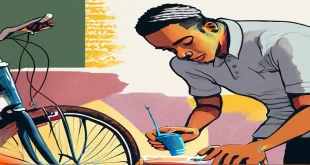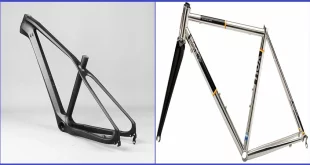Yes, packing tape can be used to protect your bike frame effectively and efficiently. Protecting your bike frame is essential to prevent scratches and damage.
Packing tape provides a simple and cost-effective solution to safeguard your bike against potential harm. The tape creates a protective barrier that guards the frame from scratches, dings, and other types of impact. It also helps to shield the frame from dirt, debris, and moisture during transportation or storage.
Applying packing tape to the vulnerable areas of your bike frame, such as the top tube and chainstay, adds an extra layer of protection without adding significant weight or bulk. So, whether you’re traveling or storing your bike, using packing tape is a smart and practical way to safeguard your prized possession.
The Benefits Of Using Packing Tape For Bike Frame Protection
Your bike is more than just a means of transportation – it’s an investment. Whether you’re a casual rider or a seasoned cyclist, you want to make sure your bike stays in top condition for as long as possible. One simple and cost-effective solution for protecting your bike frame is packing tape.
You may be surprised to learn the many benefits of using packing tape for bike frame protection. We’ll explore three key advantages it offers: protecting your bike from scratches and dings, preventing damage during transportation or storage, and being a cost-effective solution for frame protection.
Protecting Your Bike From Scratches And Dings:
- Packing tape provides a transparent barrier that shields your bike frame from scratches and dings caused by everyday use and external factors.
- It adheres firmly to the surface of your frame, creating a protective layer that absorbs minor impacts and prevents potential damage.
- With its strong adhesive properties, packing tape acts as a shield against debris, sand, and other abrasive materials that can scrape the surface of your bike frame.
Preventing Damage During Transportation Or Storage:
- When you need to transport or store your bike, the risk of it getting scratched or dented increases significantly. Packing tape provides an extra layer of protection during these times.
- By covering vulnerable areas, such as the top tube, down tube, and chainstays, with packing tape, you can safeguard your bike from potential damage caused by accidental bumps or even mishandling.
- The flexibility and durability of packing tape allow it to conform to the shape of your bike frame, ensuring complete coverage and protection.
Cost-Effective Solution For Frame Protection:
- Compared to specialized bike frame protectors or wraps, packing tape is a much more affordable alternative without compromising on its effectiveness.
- Packing tape is readily available in most households or can be easily purchased in stores or online.
- Investing in a roll of packing tape not only gives you a long-lasting solution for bike frame protection, but it can also be used for other purposes like securing packaging or organizing household items.
Packing tape offers several benefits for protecting your bike frame. It acts as a reliable shield against scratches and dings, prevents damage during transportation or storage, and provides a cost-effective solution for frame protection. By taking advantage of this versatile and readily available tool, you can keep your bike looking and performing its best for years to come.
How To Properly Apply Packing Tape To Your Bike Frame
Keeping your bike in pristine condition is essential for a smooth and safe ride. One way to protect your bike frame from scratches and damage is by using packing tape. But how do you properly apply packing tape to your bike frame?
Let’s dive into the key steps to ensure a seamless application and avoid any potential damage to your beloved bike.
Choosing The Right Type Of Packing Tape:
- Opt for a high-quality packing tape specifically designed for securing and protecting items during transit.
- Look for packing tape that is durable, weather-resistant, and provides a strong adhesive bond.
- Consider transparent packing tape to allow the beauty of your bike frame to shine through.
Preparing The Bike Frame Surface:
- Start by thoroughly cleaning the bike frame using a mild soap and water solution. This will remove any dirt, grease, or debris that could hinder the tape’s adhesion.
- Ensure the bike frame is completely dry before applying the tape to prevent any moisture from getting trapped underneath.
Applying The Packing Tape Smoothly And Evenly:
- Begin by cutting the packing tape into suitable lengths, allowing for easy handling during application.
- Start from one end of the bike frame and apply the tape firmly, ensuring it adheres to the surface without any air bubbles.
- Take your time and work your way around the bike frame, overlapping the tape slightly for comprehensive coverage.
- Smooth out any wrinkles or creases as you go to achieve a seamless and neat finish.
- Pay extra attention to areas prone to scratches and chipping, such as the chainstays, headset, and bottom bracket. Apply multiple layers of tape if necessary.
Removing And Replacing The Tape Without Damaging The Frame:
- When it’s time to remove the tape, apply gentle heat with a hairdryer to soften the adhesive. This will facilitate easy removal without leaving any residue behind.
- Use a clean, soft cloth to wipe away any remaining adhesive or dirt from the bike frame.
- If you wish to reapply the tape, ensure the surface is clean and dry before proceeding with the steps mentioned earlier.
By following these steps, you can protect your bike frame effectively with packing tape. Remember, proper application and careful removal are crucial to avoid any potential damage. So, go ahead and enjoy your rides worry-free, knowing your bike frame is well-guarded against scratches and abrasions.
Alternative Methods For Bike Frame Protection
When it comes to protecting your precious bike frame, packing tape might not be your best option. Luckily, there are alternative methods that can provide better protection and ensure the longevity of your bike. Let’s explore three effective methods for safeguarding your bike frame: using specialized bike frame protectors, wrapping the frame with bubble wrap or foam tubing, and applying clear paint protection film.
Using Specialized Bike Frame Protectors:
- Bike frame protectors are designed specifically to shield your bike frame from scratches, dings, and other forms of damage.
- These protectors come in various forms, such as adhesive patches or protective sleeves, which can be easily applied to the vulnerable areas of your bike frame.
- High-quality frame protectors are made from durable materials that are resistant to wear and tear, ensuring long-lasting protection for your bike.
Wrapping The Frame With Bubble Wrap Or Foam Tubing:
- This method involves covering your bike frame in a layer of bubble wrap or foam tubing to create a cushioned barrier against potential harm.
- Bubble wrap provides excellent shock absorption, while foam tubing offers added protection against scratches and abrasions.
- Ensure that the wrap or tubing is secured tightly to the frame to prevent it from shifting during transportation or storage.
Applying Clear Paint Protection Film:
- Clear paint protection film, also known as ppf, is a transparent adhesive film that can be applied to your bike frame to safeguard it from scratches, stone chips, and uv damage.
- This thin and flexible film adheres to the contours of your bike frame, virtually becoming invisible while providing reliable protection.
- It is important to apply the film correctly, following the manufacturer’s instructions, to achieve optimal results.
While packing tape may not be the ideal choice for protecting your bike frame, there are alternative methods that offer better results. Whether you opt for specialized bike frame protectors, wrapping your frame with bubble wrap or foam tubing, or applying clear paint protection film, each method has its advantages.
Consider your specific needs and the level of protection you require, ensuring that your bike frame remains in top condition for years to come.
Tips For Maintaining Bike Frame Protection
Regularly inspecting and cleaning the packing tape or other protective materials:
- Ensure that the packing tape or other protective materials are in good condition and securely attached to the bike frame.
- Regularly inspect the tape for any signs of wear and tear, such as fraying or peeling.
- If you notice any damage or loose tape, remove it and replace it with a new one to ensure continuous protection.
- Clean the tape by gently wiping it with a damp cloth to remove dirt, dust, and grime.
Being cautious when transporting or storing the bike:
- When transporting your bike, whether in a car or on a bike rack, take extra care to prevent any potential damage to the frame.
- Use padded bike bags or soft padding material to protect the frame from scratches and impacts during transportation.
- Avoid placing other heavy objects on top of the bike or leaning it against sharp surfaces that may cause damage.
- Store your bike in a safe and secure place, away from harsh weather conditions and potential hazards.
Avoiding abrasive surfaces or harsh chemicals that could damage the tape:
- Be mindful of the surfaces you place your bike on, avoiding rough or abrasive surfaces that could scrape or scratch the tape.
- Avoid exposing the tape to harsh chemicals or solvents that may cause it to deteriorate or lose its adhesive properties.
- If you need to clean your bike frame, use mild soap and water, or bike-specific cleaning products that are safe for the tape and frame.
Reapplying or replacing the tape as needed for continued protection:
- Over time, the packing tape or other protective materials may wear out or lose their effectiveness.
- Regularly check the tape to ensure that it is still providing adequate protection for your bike frame.
- If the tape becomes damaged or starts to peel off, remove it and apply a fresh layer to maintain the frame’s protection.
- Consider using high-quality, specially-designed frame protection products for added durability and enhanced shielding against potential damage.
Remember, taking proper care of your bike frame is crucial to ensure its longevity and optimal performance. By regularly inspecting and cleaning the packing tape or other protective materials, being cautious during transportation and storage, avoiding abrasive surfaces and harsh chemicals, and reapplying or replacing the tape as needed, you can effectively protect your bike frame and enjoy countless miles of smooth and enjoyable rides.
Conclusion
Packing tape can be a quick and affordable solution to add an extra layer of protection to your bike frame. It creates a barrier against scratches, dings, and even minor impact. The tape’s adhesive properties ensure a secure bond, and its flexibility allows it to conform to the different contours of your bike frame.
However, it is important to keep in mind that packing tape is not a substitute for proper bike maintenance and care. Regular inspections, cleaning, and proper storage are still essential. Additionally, if you frequently transport your bike or ride in extreme conditions, investing in a bike-specific protective cover or wrap may offer better long-term protection.
Nonetheless, for occasional use or small touch-ups, packing tape can provide an interim solution to safeguard your bike frame against the elements and keep it looking newer for longer.
 CommutingLife Explore The World On Two Wheels
CommutingLife Explore The World On Two Wheels





